|
 |
|
 |
|
|
|
 |
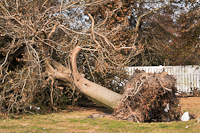 Ice storms, lightning
and strong winds can often lead to damage on
ornamental trees in our landscapes. Branches may
break, trunks may split or, in extreme, the tree may
topple over to the ground. Even having a major
branch or the trunk of the tree bend over to the
ground without breaking may lead to damage such as
canker diseases later on. Ice storms, lightning
and strong winds can often lead to damage on
ornamental trees in our landscapes. Branches may
break, trunks may split or, in extreme, the tree may
topple over to the ground. Even having a major
branch or the trunk of the tree bend over to the
ground without breaking may lead to damage such as
canker diseases later on.
At times, you can
deal with this type of damage by yourself. However,
sometimes it requires the services of professional
arborists with their specialized knowledge and
equipment.
|
|
 |
|
Determining the Extent of the
Damage |
In the home
landscape, you may have inherited certain fast
growing, weak wooded trees such as silver maple,
Chinese elms,
boxelder,
poplars and others. These
are prone to breaking into pieces under the stress
of ice or wind. They may lose branches or twigs in
any kind of storm and should be avoided when
selecting new trees for your landscape.
Minor damage such as
a few broken small branches or twigs may need no
treatment at all. However, when major branches or
the main trunk are involved, your first decision may
be whether the entire tree needs to come down.
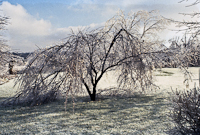 Imagine what the tree
would look like with the damaged parts removed.
Would it still be aesthetically pleasing and would
it fulfill the design intent it was meant to fill.
Finally, would the tree be safe? Sure you can prune
or cable the damaged parts but will it be safe to
walk under or would it fall onto a house, garage or
play area for the kids? It is generally best to be
conservative when the health and safety of our loved
ones or others are at risk. Imagine what the tree
would look like with the damaged parts removed.
Would it still be aesthetically pleasing and would
it fulfill the design intent it was meant to fill.
Finally, would the tree be safe? Sure you can prune
or cable the damaged parts but will it be safe to
walk under or would it fall onto a house, garage or
play area for the kids? It is generally best to be
conservative when the health and safety of our loved
ones or others are at risk.
If you don't feel
competent to make a decision on a tree, there are
usually professionals in the area called arborists
or consulting foresters who are trained to evaluate
the soundness of a tree. For a fee, they will
perform various tests and observations of your tree
and give you a recommendation.
|
 |
|
 |
|
Fixing a Damaged Tree |
If the tree is worth
saving, the next decision you need to make is
whether you are the one to do it. Trimming of minor
branches near ground level can be done with hand
tools. However, larger and higher branches will
require someone to climb into the tree or use a
"cherry picker" machine. That can be dangerous for
the untrained gardener.
To find a
professional to trim and/or cable the damage tree,
check with your local tree nurseries or a local city
forester for recommendations. Get recommendations
from prior clients before selecting a company to do
the job.
|
 |
|
 |
|
Pruning Damaged Branches |
Whether you or a professional company are doing
the job, there are certain rules and techniques for
properly removing damaged wood from a tree.
As in any kind of pruning, there are proper
techniques to assure that the tree will not be
damaged even more.
-
Cut back damaged branches
to the nearest lateral branch, bud or to the
main stem - Never just cut the branch at
the middle or leave a stub. This will only
result in the death of the branch below the cut
or form a mass of sprouts called a witches'
broom.
|
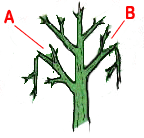 |
Cut broken branches adjacent to the next larger branch (A) If the cut is made immediately below the break (B), decay of the protruding stub is likely. |
-
Branches that are smaller
than a couple of inches should be removed with
pruning shears, loppers or a pole pruner
- Use sharp, bypass pruners to make a clean cup
so that you do not tear the bark or make a
ragged cut. Dull tools will crush rather
than cut and make an unpleasant looking result
that may also be more susceptible to insect or
disease.
-
On branches too thick to
be cut by hand pruning shears or loppers use a
sharp saw - Whenever you think about
using a saw to cut a branch, you will be dealing
with a heavy piece of wood. If you just cut down
from the top, when you get close to the bottom,
the weight of the branch will cause it to break
loose and strip some of the bark off beneath the
cut. This damage to the bark may result in a
disease called canker which will further
disfigure the tree.
To avoid this, the so-called three cut method is
recommended whenever you cut a branch with a
saw. See the figure below for the details.
|
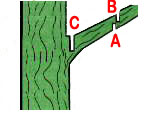 |
Remove larger branches using a 3-cut approach. Make the first cut (A)
part way through the branch. Follow with the overcut (B) which allows the branch to fall. The final cut (C) removes
the branch just outside the collar of the main stem.
Do NOT use a flush cut which leaves a
much larger wound that could lead to
problems later. |
|
 |
|
 |
|
Dealing with Torn Bark |
When major branches
are stripped from the tree during a storm, they may
also tear strips of bark off the trunk on their way
down. About the only thing you can do is to "clean
up" the wound to avoid additional damage by insects
or disease.
The key is to remove
any flaps or loose bark from the wound. Carefully
peel back the bark until you find where it is
tightly attached to the wood. Use a sharp utility
knife or other such instrument to cut away the loose
bark. Ideally, the trimmed bark should end up in an
elliptical shape as shown in the illustration below.
|
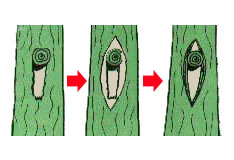 |
Treat all bark wounds to form an
elliptical bark
tracing. This encourages closing of the wound
with minimal wood decay. |
|
 |
|
 |
|
Dealing with Split Forks |
Repairing the Split -
If a major fork between two branches or between a
major branch and the trunk have split, there is a
possibility that it can be fixed. Cable or large
metal bolts are often employed to pull the two parts
back together. If this is done promptly after the
damage occurs, there is hope that the two parts will
grow back together similar to the way a scion and
stock are joined during grafting.
Cabling or bolting
like this generally needs to be done by
professionals. It takes some high powered equipment
and know how to do this properly. To do it
improperly will only result in a weakened connection
between the two parts that might come down without
warning.
|
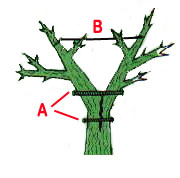 |
Install a steel bolt (A) through
the split fork of a tree to help hold it together.
Place a cable higher in the tree (B) between
the same branches to reduce the likelihood
of further breakage. |
Removing the Split - If
the forked branch is too damaged or heavy to pull
back together with the trunk, it will need to be
removed. To do this, you need to do the 3 cut
techniques as described earlier. Be sure that the
cuts are made at an angle which will allow rain
water to drain away from the cut. If it is flat, the
water accumulation could lead to rot which with
further weaken the tree.
|
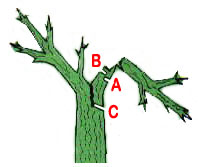 |
Remove a member of a split or broken fork which cannot be repaired using the
3-cut procedure. |
|
 |
|
 |
|
Wound Treatments |
Generally, treating cut wounds with a "wound
compound" is not recommended. This is especially
true for those products that are thick like tar.
Research indicates that these materials either do no
good or hold moisture next to the wound and may
cause additional rot to occur. For aesthetic
purposes, you might apply some of the aerosol sprays
that will help the wound be less noticeable.
The exception to this
rule includes whenever members of the red oak group
are pruned during the growing season i.e. when
leaves are present. These trees are susceptible to a
disease called oak wilt which is spread by bark
beetles that move from tree to tree. The insects are
attracted to fresh, moist wounds. The best way to
deal with this problem is to only prune these trees
during the dormant season of late fall and winter.
The insects are not active then and the tree wounds
do not need to be protected.
|
 |
|
 |
|
Uprooted Trees |
In the case of severe
wind storms or tornadoes, some trees may be pushed
over exposing their roots. Occasionally, these trees
can be saved with some quick action.
First, the tree
cannot be too large since it will take some power to
pull them back into an upright position. This
requires power equipment or wenches and cables
capable of pulling the weight of the tree.
Before pulling the
tree back up, remove some of the soil from the area
where the roots will land. This will allow them to
settle in and be at the proper level in the soil.
Once the tree is back
in the hole, water it thoroughly to eliminate air
spaces and to be sure the soil fills in around the
root system. It will be important to keep the soil
moist but not water logged for the next year or two.
The tree must re-establish its fibrous roots to
survive.
You will need to
brace the tree with 3 guy wires anchored to solid
posts in the ground. Otherwise, a weaker wind will
send the tree over again.
IF you are fortunate,
the tree will re-root and lose only a few twigs or
branches and go on to lead its normal life. The
younger the tree and the quicker you act, the more
likely this is to occur. If the roots are allowed to
dry out while in the air, the chances of success are
greatly decreased.
|
 |
|



